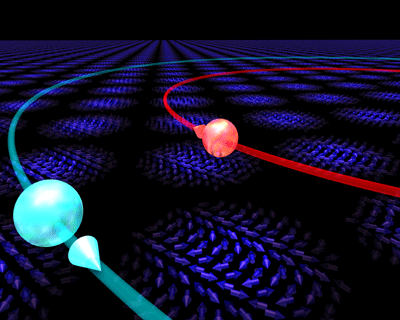Superconductors are materials that conduct electricity with no resistance. Electricity comes from electrons traveling through wire conductors. Those electrons bumping into each other generate an enormous amount of heat. With superconductors, however, there is no jostling, therefore no heat. But there's a catch: "High-temperature" superconductors (a very relative term) only behave this way when they are cooled to liquid nitrogen temperatures – between -346°F and -320.44°F.
Scientists have been unable to decipher just how copper-oxide HTS materials become superconductors. In its natural state, copper-oxide behaves like a permanent magnet. Scientists "dope" the material – which involves adding impurities to increase the number of electron carriers – and as a result of the doping and the cooling, the material turns into a superconductor, with the doped electrons pairing up to effortless carry electricity. But how, and where in the material, does this happen?

How does a magnet that cannot transport electricity transform into a superconductor that is a perfect conductor of electricity?
That question has baffled physics researchers for more than 20 years. Solving this mystery has become somewhat of a quest because the answer holds immense potential for power transmission with no energy loss, super-fast levitating trains, powerful supercomputers, and a host of other applications.
Collaboration among scientists from England, Canada and the National High Magnetic Field Laboratory is bringing scientists much closer to the answer. Their results are published in the July 10 issue of Nature.
"We have been able to shed light on the location in the electronic structure where 'pockets' of doped carriers gather," said Suchitra Sebastian, the Trinity College Research Fellow at the University of Cambridge and lead author on the paper. "Our experiments have thus made an important advance toward understanding how superconducting pairs form out of these pockets."
Without this breakthrough, the next step of detecting the glue that binds the carriers together and makes them superconduct would be impossible.
Scientists have struggled to access what happens on a microscopic scale once the material begins to superconduct, because superconductivity deftly hides its inner workings from experimental probes. Using high magnetic fields generated by the Magnet Lab's 45-tesla Hybrid magnet, the scientists were able to punch through areas of the superconducting shroud, allowing them to probe the underlying electronic structure.
And what they found raised a new tantalizing question. Based on the location, number and size of the carrier pockets revealed by their experiments, it appears that magnetism may persist even while most of the material turns superconducting. The results suggest some sort of interplay between magnetism and superconductivity. But do these very different physical phenomena compete or cooperate, and how? Those questions remain unanswered.
"What's unusual about magnetism when it coexists with unconventional superconductivity is that it seems to prefer an incommensurate structure, but why this occurs is presently a mystery," said Harrison of the Magnet Lab's Los Alamos branch and a co-author on the paper. "How exactly the copper atoms share their spin degrees of freedom between the antiferromagnet and the superconductor is likely to provide important clues as to the underlying mechanism of superconductivity."
Other co-authors on the paper are Chuck Mielke of the Magnet Lab's Los Alamos branch; Eric Palm and Tim Murphy of the Tallahassee branch of the Magnet Lab, where the experiments were performed; Ruixing Liang, Doug Bonn, and Walter Hardy, all of the University of British Columbia and the Canadian Institute for Advanced Research; and Gilbert Lonzarich with the University of Cambridge.
The work was supported by the National Science Foundation, the U.S. Department of Energy, the state of Florida, the United Kingdom Engineering and Physical Sciences Research Council, the Canadian Institute for Advanced Research, and the Natural Sciences and Engineering Research Council of Canada.






Comments